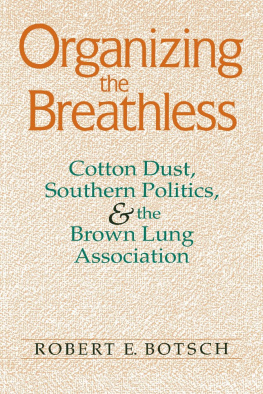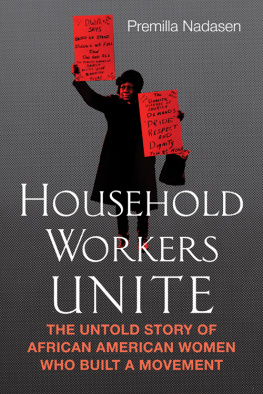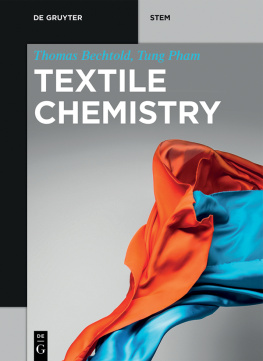Organizing
the
Breathless
Organizing
the
Breathless
Cotton Dust,
Southern Politics,
& the
Brown Lung
Association
ROBERT E. BOTSCH
Copyright 1993 by The University Press of Kentucky
Scholarly publisher for the Commonwealth,
serving Bellarmine College, Berea College, Centre
College of Kentucky, Eastern Kentucky University,
The Filson Club, Georgetown College, Kentucky
Historical Society, Kentucky State University,
Morehead State University, Murray State University,
Northern Kentucky University, Transylvania University,
University of Kentucky, University of Louisville,
and Western Kentucky University.
Editorial and Sales Offices: Lexington, Kentucky 40508-4008
Library of Congress Cataloging-in-Publication Data
Botsch, Robert Emil, 1947
Organizing the breathless : cotton dust, southern politics, and the Brown Lung Association / Robert E. Botsch.
p. cm.
Includes bibliographical references and index.
1. Cotton manufactureHealth aspectsSouthern States. 2. ByssinosisSocial aspectsSouthern States. 3. Brown Lung AssociationHistory. 4. Cotton dustHealth aspectsSouthern States. 5. Textile workersHealth and hygieneSouthern States. I. Title.
RC965.C77B68 1993
363.11 967721975dc20 92-42053
ISBN: 978-0-8131-5136-6
To my mother and father
CONTENTS
ABBREVIATIONS
| ACGIH | American Conference of Governmental Industrial Hygienists |
| ACTWU | Amalgamated Clothing and Textile Workers Union |
| AFL-CIO | American Federation of LaborCongress of Industrial Organizations |
| ATMI | American Textile Manufacturers Institute |
| BCPP | Birmingham Citizen Participation Program |
| BLA | Brown Lung Association |
| BLOC | Breath of Life Organizing Campaign |
| BWAC | Brooklyn Welfare Action Council |
| CETA | Comprehensive Employment and Training Act |
| COLD | Chronic Obstructive Lung Disease |
| COPD | Chronic Obstructive Pulmonary Disease |
| CWP | Communist Workers Party |
| EPA | Environmental Protection Agency |
| IUD | Industrial Union Department |
| LCHA | Love Canal Homeowners Association |
| NIOSH | National Institute for Occupational Safety and Health |
| OCS | Officer Candidate School |
| OSHA | Occupational Safety and Health Administration |
| PIRG | Public Interest Research Groups |
| SIOH | Southern Institute for Occupational Health |
| SNCC | Student Nonviolent Coordinating Committee |
| SSDI | Social Security Disability Income |
| TWUA | Textile Workers Union of America |
| UMW | United Mine Workers |
| VISTA | Volunteers in Service to America |
| WHO | World Health Organization |
ACKNOWLEDGMENTS
This book, like any book, would not have been possible without the help and assistance of many people. Members and former members of the Brown Lung Association were kind, courteous, and generous in sharing their thoughts and feelings over more than a decade. They continued to talk to me even after reading early versions of papers I wrote that were not entirely complimentary. Former staffers were willing to talk to me both on and off the record at odd hours and odd places and sometimes drove considerable distances to meet me. They went beyond facts to share their own thoughtful insights and evaluations.
Dr. Robert Castellan of the National Institute of Occupational Safety and Health was most patient. He helped me understand the current state of research on the subject of byssinosis and pointed me to sources that do not show up in normal bibliographical searches.
I am particularly grateful to the textile executives and managers who gave me their time and perspectives, knowing full well that the story was not one that would heap praise on the industry. Openness and tolerance of criticism are important steps in creating a more positive vision of some future South.
Paul Cimbala, who left the South to study it from the safe distance of Fordham University, gave this ahistorical political scientist significant help with historical context patiently reading early drafts sent to him in bits and pieces. Tom E. Terrill, another scholar of the South, offered a number of constructive criticisms in his reading of an early draft. Ben Judkins deserves my thanks in several ways. This book builds on his pioneering sociological study (1986) of the Brown Lung Association. In addition to providing a foundation, he generously gave of his time, reading a late draft of the manuscript and making helpful and supportive suggestions.
I am grateful to Val Lumans and the rest of the administrators at the University of South Carolina, Aiken, for allowing me a semesters sabbatical. The five months they gave me, thought it seemed like five weeks, allowed me to get the bulk of the writing accomplished.
My best critic and helpmate, Carol Sears Botsch, taught extra classes to help support our family while I was laboring on this project. Beyond that, she listened and encouraged me when I had doubts, vastly improved my prose with her suggestions, and quieted the children when I was doing telephone interviews. Far from least important, she reminded me to save computer files frequently when spring thunderstorms rumbled across the midlands of South Carolina. I also thank my children, David and Matthew, who are far too old and full of energy to take naps, as David did when I wrote my first book, but were quiet and understanding when I needed extra time.
I could just about feel something inside that told me all the things he said were true. He used to sit here and tell me how strong men were in the Valley when they were young and how weak they were when they grew up breathing cotton lint into their lungs and dying with blood on their lips.
Erskine Caldwell
Gods Little Acre, 1933
INTRODUCTION. A SOUTHERN TRAGEDY
The Valley is a series of small mill towns that lie along Horse Creek between Aiken, South Carolina, and Augusta, Georgia. When I came to South Carolina in 1978, I learned that this was the same valley Erskine Caldwell had described in Gods Little Acre. In this tale of eccentric and fiercely romantic individualists, Caldwell made several references to weak old workers who were spitting their lungs into the yellow dust (1933, 123). Some forty years later novelist Pat Conroy described the same area in a biting indictment of worker exploitation by local mills:
For twenty miles America has a savage and well preserved vision of what was wrong with the industrial revolution.... The Valley shelters a grim and fiercely proud native .... The mill is in his blood.... History has trapped him.... The only organization they have is The Mill. The Mill cares for them, entertains them, takes care of their sick, and is always ready to perform fatherly duties if emergencies arise. No one can convince the people of the Valley that the reason they are so buried in this miasma of hopelessness is directly due to the benign shepherding of the Mill. No one has told these people along the long sad highway that the Mill is guilty of high crimes, unforgivable crimes, crimes for which they would fiercely deny responsibility. [1974, 52-54]








